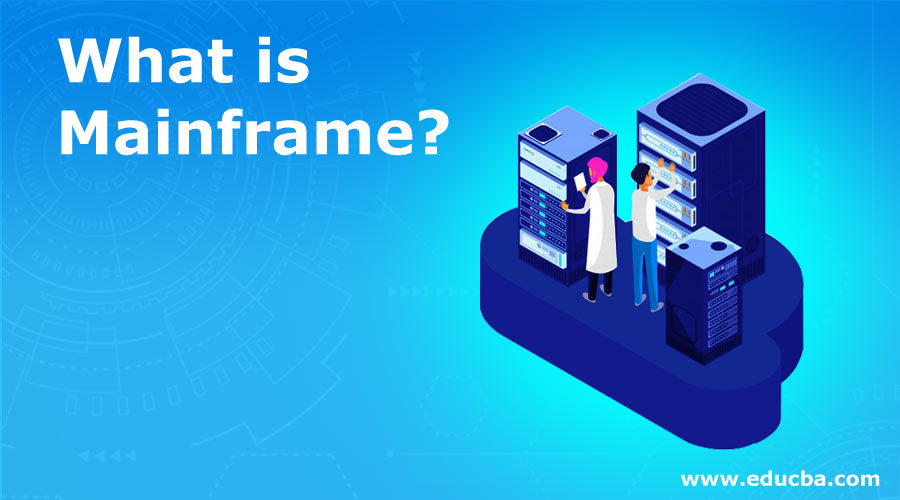Updated March 13, 2023
Introduction to Mainframe
The computers used in large organizations to manage critical applications such as bulk data processing, enterprise resource planning and transaction processing is called mainframe computers. The performance is relatively higher than any other systems, and a large amount of memory and processors are used in the systems. Mainframe is a technology where the requests received are processed fast and sent to the related processor cards. These systems are used by major IT companies and Walmart, NASA etc. Mainframes will be used in the nearby future and will not die soon. The computers are a stable stock of systems for many companies.
Understanding Mainframe
The major components of mainframe environments are below,
- JCL
- COBOL
1. JCL
Job Control language is the expansion for JCL; processing data in batches is the key principle behind JCL. JCL is an authoritative and stretchy language that facilitate in operating and customizing remote resources for computers.
| Batch processing | Interactive processing |
| Jobs submitted are executed at a later time | Jobs submitted are executed immediately |
| Non-interaction between the available users | Flexible interaction between the associated users |
| Debugging is archived through snapshot | Debugging in a much more interactive manner |
Stages of JCL execution,
- Input – Job number has exclusively been tagged for each job
- Conversion – Job listed in JES spool, preparing it for execution
- Initiator – Job will be triggered for execution from the spool
- Execution – Actual running of the job
- Output – All associated devices receive the output
- Purge – Purging the job is the last step that takes place after the completion in the execution of the job
Ex:-
//LMSBCE5D JOB 'Q868144,TSSS,D','USER Q868144',
//CLASS=K,MSGCLASS=X,MSGLEVEL=(1,1),REGION=0M, REGION=900M
//NOTIFY=Q868144 TYPRUN=SCAN
//********************************************************************
//S010 EXEC PGM=DFSRRC00,
//PARM=(DLI,LMSBCE5D,GDMINQU,8,0000,,0,,N,0,T,,,Y,Y,IRLT,N,),
//REGION=8M
//STEPLIB DD DSN=IMS.TEST.SDFSRESL,DISP=SHR
//DD DSN=IMS.TEST.DYNALLO,DISP=SHR
//DD DSN=KADSCM.STGE.#010308.LDB,DISP=SHR
//DFSRESLB DD DSN=IMS.TEST.SDFSRESL,DISP=SHR
//DFSVSAMP DD DSN=KADSCM.PROD.UTILLIB(DFSVKRMS),DISP=SHR
//IMS DD DSN=IMS.TEST.PSBLIB,DISP=SHR
/DD DSN=IMS.TEST.DBDLIB,DISP=SHR
//PARMFILE DD *
20171120 20171125 U
/*
//OUTFILE DD DSN=TESTKRMS.KRMS.LMSBCE5D.DT120617,
//UNIT=SYSDA,SPACE=(CYL,(1,1),RLSE),
//DISP=(NEW,CATLG,DELETE),
//LRECL=180,RECFM=FB,BLKSIZE=0
//IEFRDER DD DUMMY
//ERRFILE DD SYSOUT=*
//REPORT DD SYSOUT=*
//DUMPER DD SYSOUT=*
//SYSLST DD SYSOUT=*
//SYSOUT DD SYSOUT=*
//SYSPRINT DD SYSOUT=*
//SYSABEND DD SYSOUT=*
//SYSDUMP DD SYSOUT=*
//SYSUDUMP DD SYSOUT=*
//SYSDBOUT DD SYSOUT=*
//SYSABOUT DD SYSOUT=*
//SYSDTERM DD SYSOUT=*
//*****************************************************************
//* OSAM BUFFER CONTROL
//DFSCTL DD DSN=KADSCM.PROD.UTILLIB(KRMSBUFF),DISP=SHR
//DFSSTAT DD SYSOUT=*
2. COBOL
In the 1950s, it Utilized majorly for data processing in business sectors as a high-level language.US Department of Defence assemble a discussion in 1958 May, and three major groups designed the new language. Cobol was the name associated with it, which expands as (COmmon Business Oriented Language) in 1959 Sep. May 1961 was the date when COBOL was officially announced. When it comes to the compiler perspective, it was designed initially in 1962; users started Cobol programs. In 1965 the superior version released. The standard version of a language, approved by ANSI (American National Standards Institute), was introduced in Aug 1968. The next revised official standard was introduced in 1974 and is known as ANSI-74 Cobol or Cobol-74.
Structure of Cobol:
- Program
- Division
- Section
- Paragraph
- Sentences
- Statements
- Words
- Characters
Character Set,
- 0 – 9: 10 numerals
- A to Z: 26 English alphabets
- or b Space or blank
- – + * / = : Minus or hyphen, plus, asterisk, slash, equal
- $ or £: Currency sign
- ,;. “ ( ) < > ‘: Other special characters
Properties of Cobol,
- The key characters in a Cobol word are as below,
- 0 – 9: 10 numerals
- AZ:26 English alphabets
- -: Hyphen
- The alphabet must be placed in at least one of the characters; on some compilers, the first letter has to be an alphabet.
- It cannot contain any special character the only allowed special character is a hyphen.
- It cannot contain a blank.
Coding Format by position-
- 1 to 6: Sequence
- 7: Indicator
- 8 to 11: Area A/margin A
- 12 to 72: Area B / margin B
- 73 to 80: Identification
What Mainframe can Do?
- Software Application Development
- E-Business and E-commerce
- Healthcare application development
- Analystics using Mainframe SAS
Advantages
Below are some advantages:
- High availability of the systems
- Extreme reliability of the systems
- Systems of extreme high availability to handle large volumes of data
- English-like constructs.
- Self-documenting systems.
Required Skills
- Virtualization
- Troubleshooting
- Programming capability
- Storage Management Part
- Escalation management
An audience for Mainframe
- Audience with interest to learn
- Individual who aspire to Mainframe Administrator and Architect, developer, Analyst, Tester also relative professional roles.
- It helps to move forward the professional aspects and technical skillset of professionals who are intended to do the same.
- Candidates with mainframe application development
Career growth
- Mainframe Application developer
- Mainframe system administrator
- Mainframe Storage Administrator
- Mainframe Application Architect
- Mainframe Support Engineer
Conclusion
Definitely, this is one of the most versatile and stable systems in over a decade. We could confidently put a statement mainframe will hold its position for any period of time. Security over the substances which the mainframe handles is also a key reason for the position which the mainframe holds. Availing a solution for almost all requirements in the market, a mainframe is hardly non-replaceable.
Recommended Articles
This has been a guide to What is Mainframe. Here we discussed the understanding, career growth, Skills, and advantages of the mainframe. You can also go through our other suggested articles to learn more –



